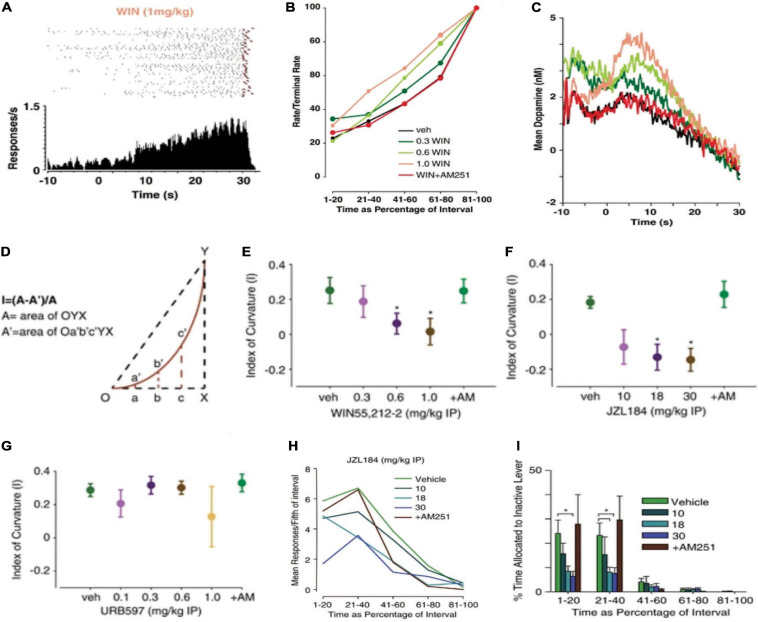FIGURE 5.
Cannabinoids modulate a temporally engendered pattern DA release during reinforcement maintained under an FI schedule and adjunctive behavior. An illustrative cumulative response pattern (top: raster plots; bottom: corresponding peri-event histograms) of a WIN-treated mouse responding for food reinforcement under a FI schedule. The pattern of lever pressing lawfully increases in the FI task to form a scalloped response pattern. The raster plot shows responses (black ticks) preceding food reinforcement (red triangle) across the 30 s interval. All trials are shown in chronological order as they occurred in a representative experimental session. The peri-event histogram shows the summation of responding under each corresponding raster plot. (A). WIN 55,212-2 accelerated the timing of scallop response pattern in a dose- and CB1-dependent manner. Mean behavioral response patterns following cannabinoid administration are plotted as a function of the interval duration (B). WIN amplified a temporally engendered pattern of DA release in a dose- and CB1-dependent manner. Mean DA concentration traces for each drug treatment conditions are plotted as a function of the interval (C). Cannabinoid-induced changes in interval timing were quantified by assessing the index of curvature—a computational measure of the extent and direction of change in the temporal response pattern produced by the FI schedule (D). WIN produced a negative index of curvature, suggesting an acceleration of timing behavior (E). Increasing 2AG with JZL184, but not increasing anandamide with URB597, accelerated interval timing (F,G). eCB-induced changes in reinforcement irrelevant or adjunctive behavior were assessed by quantifying responses on an inactive lever. Mean responses on the inactive lever initially increase before declining through the interval (H). JZL184 significantly decreased the percentage of time spent responding on the inactive lever, suggesting that adjunctive behavior was reduced by elevating 2AG levels (I). These data show that cannabinoids module periodically reinforced behavior and DA release under an FI schedule and, might suggest that a delicate balance of 2AG and DA release are necessary to produce the sweet-spot of intermittency that produces adjunctive behavior. Reproduced from Oleson et al. (2014).

